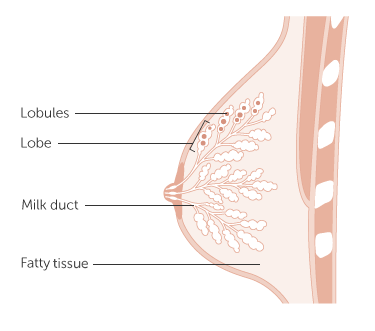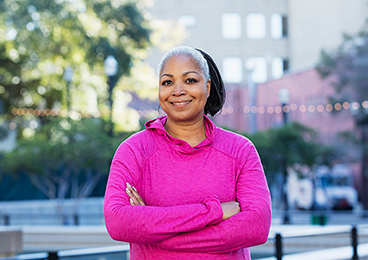Breast cancer is a disease in which cells in the breast grow out of control. There are different kinds of breast cancer. The kind of breast cancer depends on which cells in the breast turn into cancer.

Breast cancer can begin in different parts of the breast. A breast is made up of three main parts: lobules, ducts, and connective tissue. The lobules are the glands that produce milk. The ducts are tubes that carry milk to the nipple. The connective tissue (which consists of fibrous and fatty tissue) surrounds and holds everything together. Most breast cancers begin in the ducts or lobules.
Breast cancer can spread outside the breast through blood vessels and lymph vessels. When breast cancer spreads to other parts of the body, it is said to have metastasized.

Breast cancer can begin in different parts of the breast. A breast is made up of three main parts: lobules, ducts, and connective tissue. The lobules are the glands that produce milk. The ducts are tubes that carry milk to the nipple. The connective tissue (which consists of fibrous and fatty tissue) surrounds and holds everything together. Most breast cancers begin in the ducts or lobules.
Breast cancer can spread outside the breast through blood vessels and lymph vessels. When breast cancer spreads to other parts of the body, it is said to have metastasized.
The precise causes of breast cancer are unclear, but we know the main risk factors. Still, most women considered at high risk for breast cancer do not get it, while many with no known risk factors do.
Breast cancer is the most common cancer in women and 1 in 8 women will get breast cancer during their lifetime. The risk is higher for women who have some risk factors for breast cancer.


Studies have shown that your risk for breast cancer is due to a combination of factors. The main factors that influence your risk include being a woman and getting older. Most breast cancers are found in women who are 50 years old or older.
Another important risk factor is having breast cancer, ovarian cancer, prostate cancer, or pancreatic cancer in your family. The risk goes up for women with certain types of benign breast lumps and for women who have had ovarian cancer. And if you’ve had breast cancer, it’s important to understand that (a) you can also get cancer again somewhere else, and (b) only some women are more likely to get a second breast cancer.
Some women will get breast cancer even without any other known risk factors. Having a risk factor does not mean you will get the disease, and not all risk factors have the same effect. Most women have some risk factors, but most women do not get breast cancer. If you have breast cancer risk factors, talk with your doctor about ways you can lower your risk and about screening for breast cancer.
Another important risk factor is having breast cancer, ovarian cancer, prostate cancer, or pancreatic cancer in your family. The risk goes up for women with certain types of benign breast lumps and for women who have had ovarian cancer. And if you’ve had breast cancer, it’s important to understand that (a) you can also get cancer again somewhere else, and (b) only some women are more likely to get a second breast cancer.
Some women will get breast cancer even without any other known risk factors. Having a risk factor does not mean you will get the disease, and not all risk factors have the same effect. Most women have some risk factors, but most women do not get breast cancer. If you have breast cancer risk factors, talk with your doctor about ways you can lower your risk and about screening for breast cancer.
Mammograms are a very important part of preventing breast cancer and catching breast cancer early. It is recommended that average risk women 40 years of age and older get a mammogram every year. Women who are younger may also need mammograms or breast magnetic resonance imaging (MRI) in addition to mammograms if they are determined to be at higher risk for breast cancer than average.
Breast magnetic resonance imaging (MRI) is a test used to detect breast cancer or abnormalities in the breast. Images of the breast are taken during the MRI to detect these abnormalities. For some people who are at potential high risk for breast cancer (such as having a strong family history or having a gene that increases risk for breast cancer), breast MRI may be used in conjunction with mammograms to detect breast cancer.
Breast magnetic resonance imaging (MRI) is a test used to detect breast cancer or abnormalities in the breast. Images of the breast are taken during the MRI to detect these abnormalities. For some people who are at potential high risk for breast cancer (such as having a strong family history or having a gene that increases risk for breast cancer), breast MRI may be used in conjunction with mammograms to detect breast cancer.
During a mammogram, pictures of your breasts will be taken to determine if there are any abnormalities present in the breast tissue. To get a good picture, the breast tissue must be compressed. To do this, your breast will be placed between two plates. The upper plate will then be lowered to compress the breast before the pictures are taken. Some women may experience pain or discomfort while the breasts are flattened.
